
Bunge Church is a medieval church in Bunge on the Swedish island of Gotland. The church seen today was largely built during the 14th century and is in a High Gothic style typical for churches on Gotland. Inside, the church is richly decorated with medieval murals, including depictions of medieval knights whose significance remain contested. Bunge Church belongs to the Church of Sweden and lies in the Diocese of Visby (Sweden).
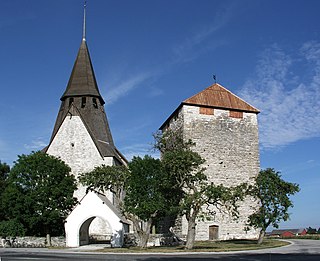
Gammelgarn Church is a medieval church in Gammelgarn on the Swedish island of Gotland. The largely Gothic church stands next to an older defensive tower. The church's main portal is richly decorated with medieval sculpture, and the interior contains an altarpiece from the 14th century of high craftsmanship. The church is in the Diocese of Visby of the Church of Sweden.

Grötlingbo Church is a medieval church in Grötlingbo on the Swedish island Gotland. The stately Gothic church contains elements of a Romanesque frieze, incorporated from an earlier church building on the same site. Görtlingbo Church lies within the Diocese of Visby.

Hejdeby Church is a medieval church in Hejdeby on the Swedish island of Gotland. The church was built in stages during the 13th century, and contains medieval muralsfrom two different periods. Hejdeby Church is part of the Diocese of Visby within the Church of Sweden.
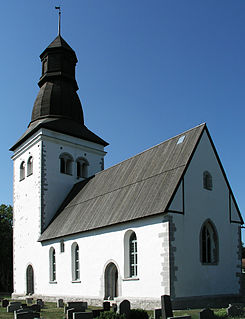
Ala Church is a medieval church in Ala on the Swedish island of Gotland. Its oldest parts date from the 12th century. Damaged by fire in the 1930s, it still contains medieval murals and its original baptismal font. The church belongs to the Church of Sweden and lies within the Diocese of Visby.

Eke Church is a medieval church in Eke on the Swedish island of Gotland. The church was built during the 12th and 13th century, with only smaller additions and changes made later. Inside, several medieval murals survive. The church is used by the Church of Sweden and lies in the Diocese of Visby.
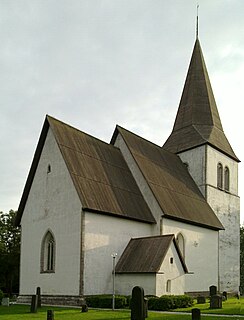
Etelmhem Church is a medieval church on the Swedish island of Gotland. The largely Gothic church contains medieval murals and a 12th-century baptismal font by the sculptor Hegvald. The church is used by the Church of Sweden and part of Diocese of Visby.

Barlingbo Church is a medieval church in Barlingbo on the Swedish island of Gotland. It dates from the 13th century and has been altered little since. It contains furnishings from several centuries, including an unusual medieval baptismal font, decorated with figures and runes. The church belongs to the Church of Sweden and lies in the Diocese of Visby.

Buttle Church is a medieval church in Buttle on the Swedish island of Gotland. It is one of the more well-preserved Romanesque churches on Gotland, and contains both a number of medieval furnishings as well medieval murals. Buttle Church belongs to the Diocese of Visby of the Church of Sweden.

Bäl Church is a medieval church in Gute, Bäl, on the Swedish island of Gotland. It was built during the first half of the 13th century and contains sculptural decoration in both Romanesque and Gothic styles. The interior is decorated by medieval wall paintings. It belongs to the parish Väskinde, in the Diocese of Visby.

Ekeby Church is a medieval church in Ekeby on the Swedish island of Gotland. The oldest parts date from the 12th century, and the church has been little altered since the end of the 13th century. Its interior is richly decorated with medieval murals. It belongs to the Church of Sweden and lies in the Diocese of Visby.

Endre Church is a medieval church in Endre on the Swedish island of Gotland, in the Diocese of Visby, built from the 12th to early 14th century. It contains medieval murals and several medieval furnishings, and belongs to the Church of Sweden.
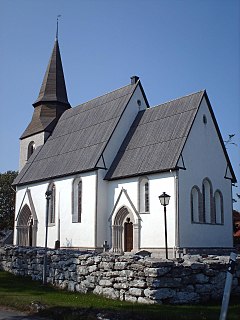
Fole Church is a medieval church in Fole on the Swedish island of Gotland. The Romanesque tower is the oldest part of the otherwise largely Gothic church. It belongs to the Church of Sweden and lies in the Diocese of Visby.
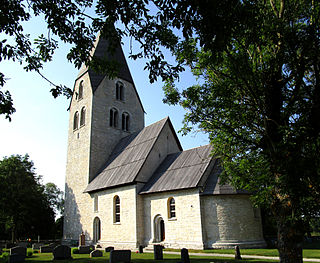
Ganthem Church is a well-preserved Romanesque church in Ganthem on the island of Gotland. It contains murals from the 15th century as well as a number of medieval furnishings. It lies in the Diocese of Visby (Sweden).
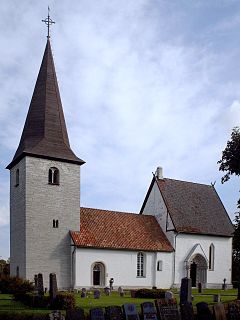
Halla Church is a medieval church in Halla on the Swedish island Gotland. It is part of the Diocese of Visby.
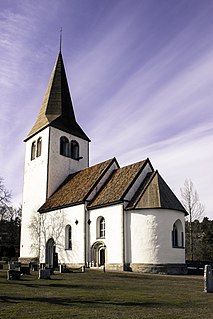
Linde Church is a medieval church on the Swedish island of Gotland. The church was built between the 12th and the early 13th century and is Romanesque in style. I lies in the Diocese of Visby.

Klinte Church is a medieval church in Klinte on the Swedish island of Gotland, not far from Klintehamn. Finished around the 1300, it is a largely Gothic church. It is part of the Diocese of Visby.
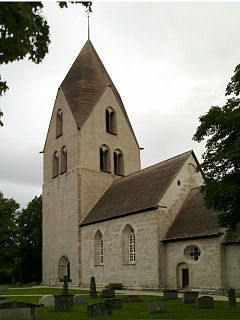
Mästerby Church is a medieval church in Mästerby on the Swedish island of Gotland. It is richly decorated with medieval murals. Mästerby Church belongs to the Diocese of Visby.

Gerum Church is a medieval church in Gerum on the Swedish island of Gotland, built between c. 1200 and 1300. It is used by the Church of Sweden.

Silte Church is an almost unaltered medieval church on the Swedish island of Gotland. Silte Church was built during the 13th century and contains a number of medieval fittings as well as murals. It belongs to the Church of Sweden and lies in the Diocese of Visby.























